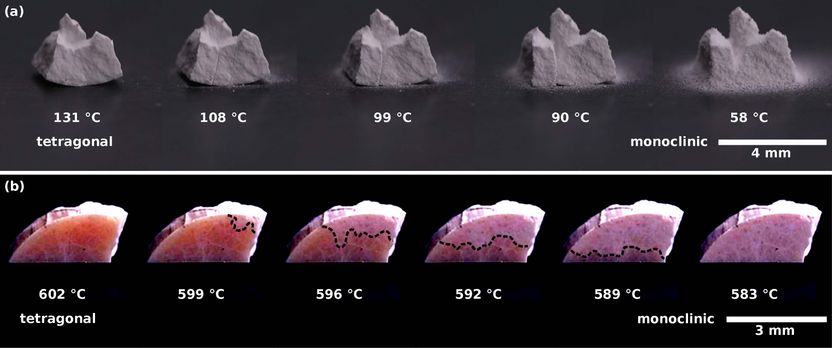Exploding and weeping ceramics
Researchers discover a path to a shape-shifting ceramic material
Advertisement
From coffee cups to bathroom tiles, ceramics are brittle. Subject to the slightest deformation, they shatter. On the other end of the spectrum of materials, some of the most deformable materials known - that also support large stresses while they deform - are shape memory alloys. The origin of this shape-shifting behavior is a solid-to-solid phase transformation. Shape memory alloys rely on this tremendous deformability when functioning as medical stents, the backbone of a vibrant medical device industry both in the Twin Cities area Minneapolis-Saint Paul (USA) and in Germany.

Upon cooling, ZrO2-based shape memory ceramics undergo phase transformation from a tetragonal to a monoclinic crystal structure. Top (a): Although the composition of the material predicts high compatibility, the ceramic disintegrates into its grains. In the ceramic in the bottom example (b), which satisfies the so-called equidistance condition, the crystal withstands the transformation (the dashed line shows the location of the phase transition).
© Jascha Rohmer
In research published open access on November 17, 2021 in Nature, Eckhard Quandt and Lorenz Kienle from Kiel University (CAU), Andriy Lotnyk from the Leibniz Institute of Surface Engineering (IOM) (all Germany), Richard James from the University of Minnesota (UMN), USA, and their students describe a pathway forward to produce a reversible shape memory ceramic.
The route was anything but straightforward for their graduate students Jascha Romer, Hanlin Gu and Justin Jetter. They first tried a recipe that has been productive for the discovery of new metallic shape memory materials. That involves a delicate tuning of the distances between atoms by compositional changes, so that the two phases fit together well. They implemented this recipe, but, instead of improving the deformability of the ceramic, they observed that some specimens exploded when they passed through the phase transformation. Others gradually fell apart into a pile of powder, a phenomenon they termed “weeping”.
At yet another composition they observed a reversible transformation, easily transforming back and forth between the phases, much like a shape memory material. The mathematical conditions under which reversible transformation occurs can be applied widely and provide a way forward toward the paradoxical shape-memory ceramic.
With this avenue now open, what can you do with a shape memory ceramic? James says, “It would be a completely new kind of functional material. There is a great need for shape memory actuators that can function in high temperature or in corrosive environments. But what excites us most is the prospect of new ferroelectric ceramics. In these materials the phase transformation can be used to generate electricity from small temperature differences.”
The team from Germany was responsible for the experimental part and the chemical and structural investigation at the nanoscale. “The collaboration with Richard James’ group was very valuable to explain our experimental discovery: Their theory describes the unexpected behavior of the extremely incompatible ceramics and also shows how to get compatible shape memory ceramics”,.says Eckhard Quandt.
“Our collaboration with Eckhard Quandt’s group has been tremendously productive”, adds James. “As in all such collaborations, there is sufficient overlap that we communicate well, but each group brings plenty of ideas and techniques that expand our collective ability to discover.



























































